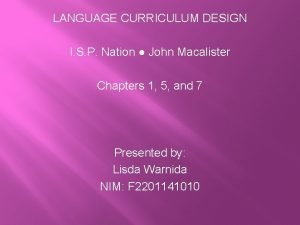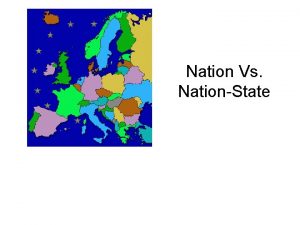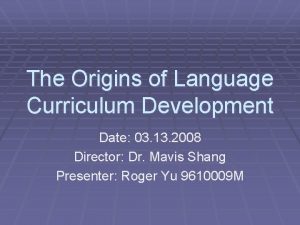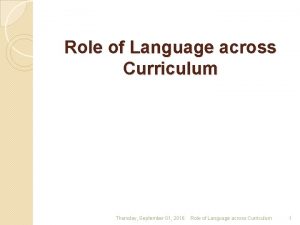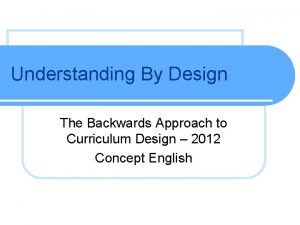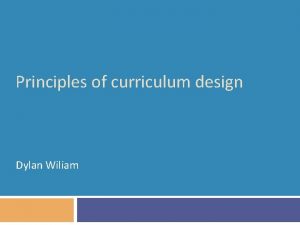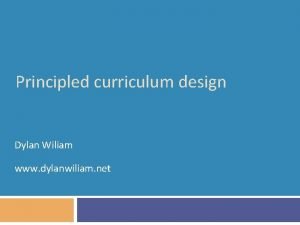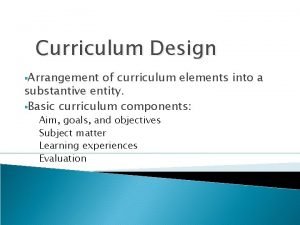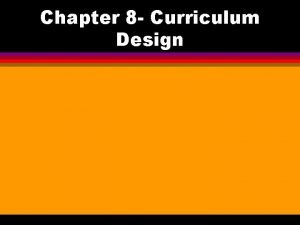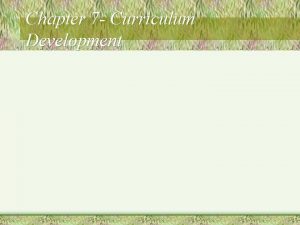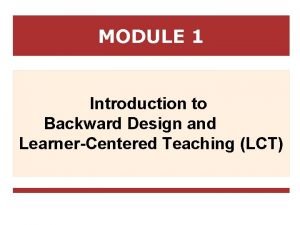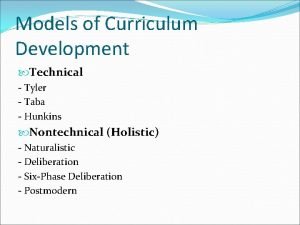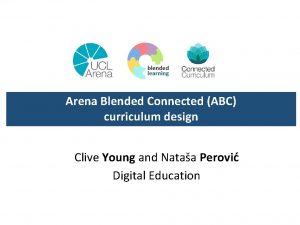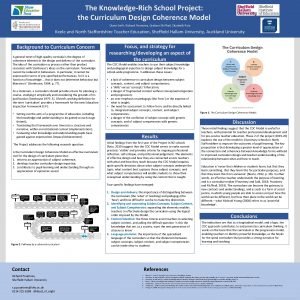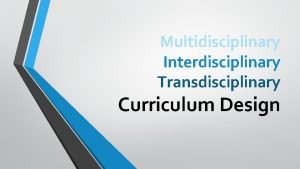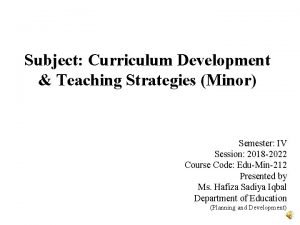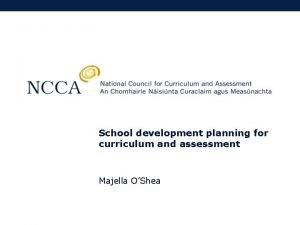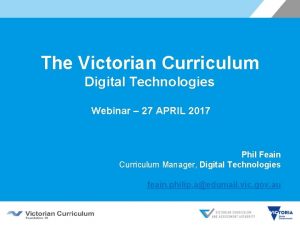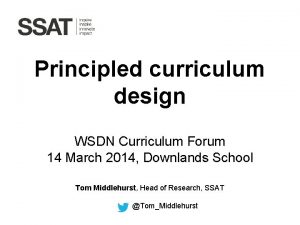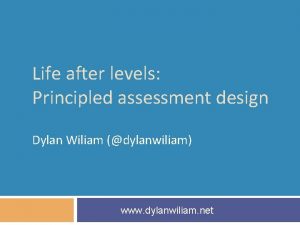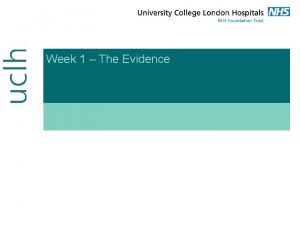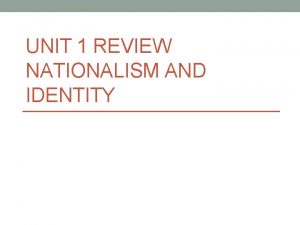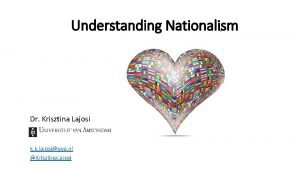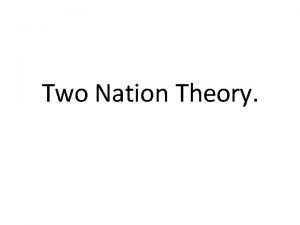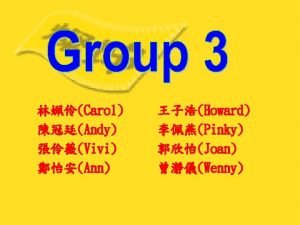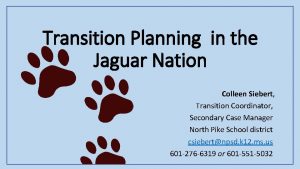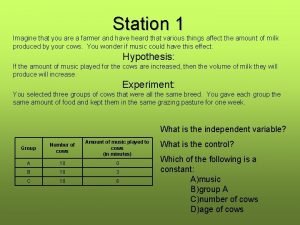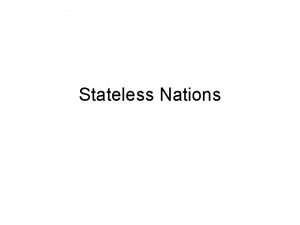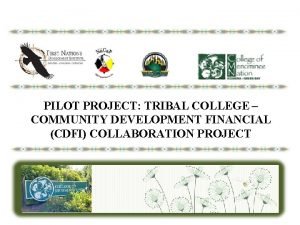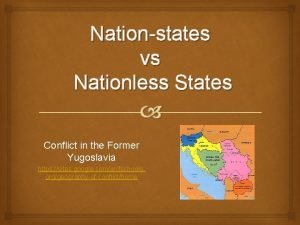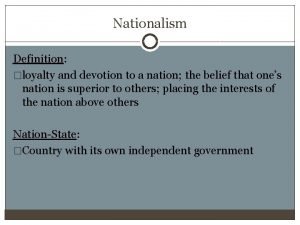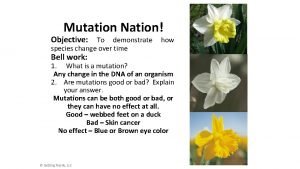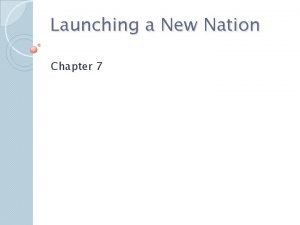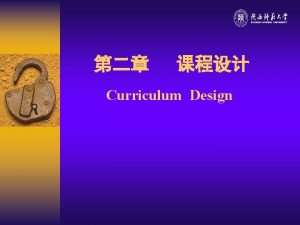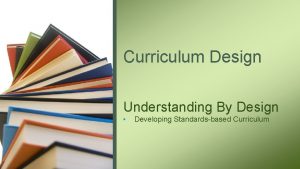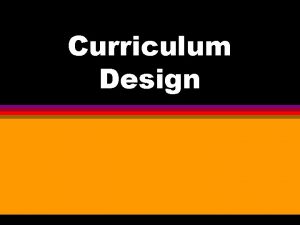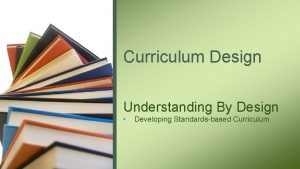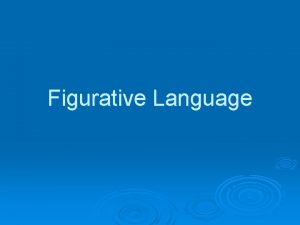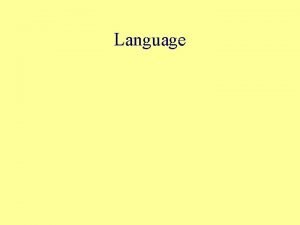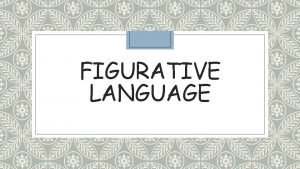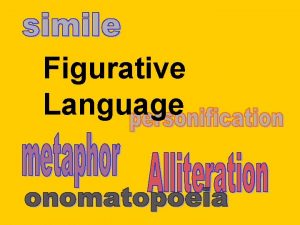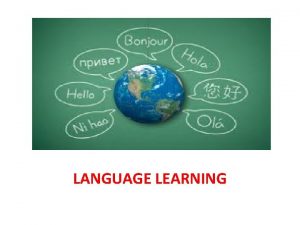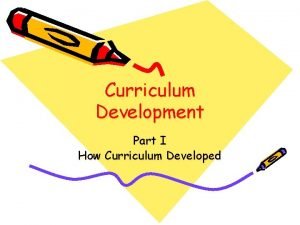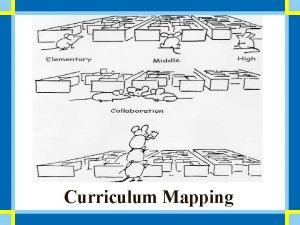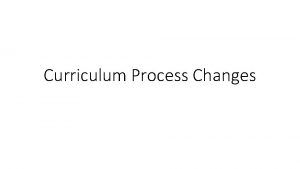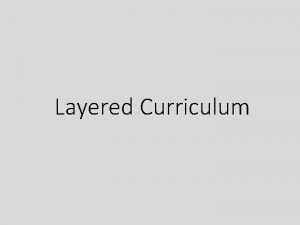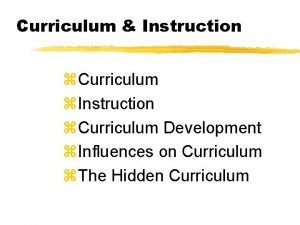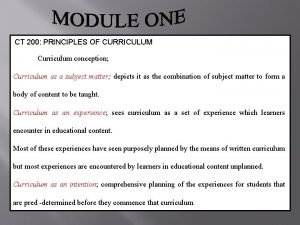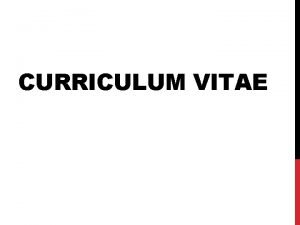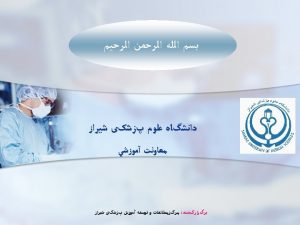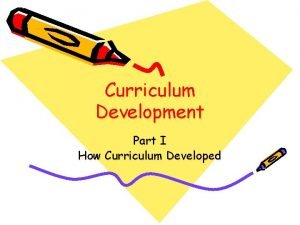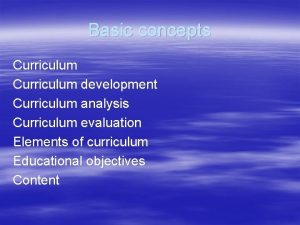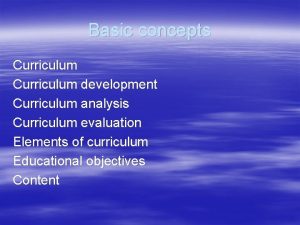LANGUAGE CURRICULUM DESIGN I S P Nation John















































- Slides: 47

LANGUAGE CURRICULUM DESIGN I. S. P. Nation ● John Macalister Chapters 1, 5, and 7 Presented by: Lisda Warnida NIM: F 2201141010

�Chapter 1 Language Curriculum Design Curriculum design can be seen as a kind of writing activity and it can be usefully studied as a process. There are 3 factors that should be considered in the curriculum design process: 1. Environment analysis 2. Needs analysis 3. Application of principles

�The result of environment analysis is a ranked list of factors and a consideration of the effects of these factors on the design. �The result of needs analysis is realistic list of language, ideas or skill items, as a result of considering the present proficiency, future needs and wants of the learners. �The result of applying principles is a course where learning is given the greatest support.

�The curriculum model in Figure 1. 1 consists of: - The outer circles (principles, environment, and needs) - The inner circles (goals, content and sequencing, format and presentation, and monitoring and assessing) § The goals is in the centre. It means to reflect the importance of having clear general goals for a course. § The content and sequencing represent the items to learn in a course. § Consideration of content makes sure that there is something useful for the learners to learn to advance their control of the language.


�The format and presentation represent the format of the lessons or units of the course, including the techniques and types of activities that will be used to help learning. �The monitoring and assessment represent the need to give attention to observe learning, test the result of learning, and provide feedback to the learners about the progress.

Considering the environment • Environment analysis involves considering the factors of the situation in which the course will be used and determining how the course should take account of them. • One way of approaching environment analysis is to work from a list of questions which focuses on the nature of the learners, the teachers and the teaching situation.

Discovering needs Hutchinson and Waters (1987) make a useful division of learners’ needs into: 1. Necessities (what the learners have to know from the function effectively) 2. Lacks (what the learner knows and does not know already) 3. Wants (what the learners think they need)

q. Following Principles • It is very important that curriculum design makes the connection between the research and theory of language learning and the practice of designing lessons and courses. q Goals • The curriculum design model in Fig. 1. 1 has goals as it is the centre. This is because it is essential to decide why a course is being taught and what the learners need to get from it. • Example of goal: The aim of communicative teaching is to encourage students to exploit all the elements of the language that they know in order to make their meaning clear. Students cannot be expected to master every aspect of the language before they are allowed to use it for communicative purposes (Orbit, Harrison and Menzies, 1986).

q Content and Sequencing § The content of language courses consists of the language items, ideas, skills and strategies that meet the goals of the course. § One way to provide a systematic and well-researched basis for a course is to make use of frequency lists and other lists of language items or skills. q Finding a Format and Presenting Material § The presentation of material in a course involves the use of suitable teaching techniques and procedures. § The advantages of having a set format for lesson are: - The lessons are easier to make. - The course is easier to monitor. - The lessons are easier to learn.

q Monitoring and Assessing § The aims of curriculum design are to make a course that has useful goals, that achieves its goals, that satisfies its users, that does all this in an efficient way. § An important recurring part of the design process is to assess how well these aims are achieved. § Assessing generally involves the use of tests.

§ There are 4 kinds of tests: 1. Proficiency test (measuring what a learner knows of the language). 2. Achievement test (measuring what has been learned from a particular course). 3. Placement test (used to see if the course is suitable for a prospective learner or to see where in the course the learner should begin). 4. Diagnostic test (used to see if learners have particular gaps in their knowledge).

q Evaluating a Course § Information gained from assessment is a useful source of data about the effectiveness of a course, but it is only one of the sources of information that can contribute to the evaluation of a course. § An evaluation of a course can have many purposes. The main one is to continue or discontinue the course, or to bring about improvement in the course.

v Chapter 5 Goals, Content and Sequencing § Goals and Content The goals of a language lesson can focus on one or more of the following things: language, ideas, skills or text (discourse). Making sensible, well-justified decisions about content is one of the most important parts of curriculum design. Some curriculum designers break goals down into smaller well-specified performance objectives (Brown, 1995).

§ The Units of Progression in the Course The units of progression in a course are the items that are used to grade the progress of the course. Long and Crookes (1993: 9 -19) call unit of progression ‘units of analysis’ and argue that the choice of the unit of analysis should be one of starting points of curriculum design.

�Task-based Syllabus Published experimentation with task-based syllabuses largely began with the work of Prabhu (1987) and the interest in this type of syllabus may be a result of the links that teachers and curriculum designers see between this approach and their own teaching and planning activities. Long and Crookes (1992), argue that a pedagogic task provides a vehicle for presentation of appropriate language samples to learners and allow negotiation of difficulty (p. 43).

q Chapter 7 Monitoring and Assessment o Monitoring and assessment can provide a teacher and learners with information about the learners’ present knowledge and progress, and it can also be a means of encouraging involvement and participation. o The purpose of the monitoring and assessment part of curriculum design is to make sure that learners will get the most benefit from the course.

o. The major types of monitoring and assessment that can occur as the part of a course are: 1. Placement assessment 2. Observation of learning 3. Short-term achievement assessment 4. Diagnostic assessment 5. Achievement assessment 6. Proficiency assessment

q Good Assessment: Reliability A reliable test gives results that are not greatly upset by conditions that the test is not intended to measure. A test is more reliabe if: - it is always given under the same conditions. - it is consistently marked. - it has large numbers of points of assessment. - its questions and instructions are clear and unambiguous. 2. Validity A valid test measures what it is supposed to measure. 3. Practicality Tests can be made more practical by having reusable test papers, by being carefully formatted for easy marking, by being not too long, and by using objectively scored items such as true/false or multiple choice. 1 .

EVALUATION BY: FERA SUKOWATI (F 2201141007)

Definition of Evaluation is a process that involves gathering information about the effectiveness of curriculum and measurement is done in terms of levels of achievement of the pre-set objectives.

Purpose and Audience of the Evaluation Audience Person/Group Commissioning the evaluation Purpose To improve the course or to guide a decision whether to maintain or get rid of the course

The Type and Focus of the Evaluation Formative Summative Purpose Improve the course Judge the course Type of data More likely to look at causes, processes, individuals More likely to look at results, standards, groups Use of data Used for counseling, mentoring, professional development, setting goals, and adapting material Used to make decisions on adequacy Presentation of findings Presented to and discussed with individuals Presented in a report

Gathering the Information � Interviews are usually conducted on a one to one basis, but it is sometimes useful to interview a committee or to use a staff meeting as a way of gathering data. � Self-Report scales it is a type of survey, questionnaire or poll in which respondents read the question and select a response by themselves without the researcher’s interference. It is any method which involves asking a participant about their feelings, attitudes, beliefs and so on. � Observation and checklist An observation checklist is a list of things that an observer is going to look at when observing a class. This list may have been prepared by the observer or the teacher or both.

Approaches to Curriculum Design

Model of Curriculum Design


Doing Curriculum Design This book has taken the approach that curriculum design is best viewed as a process like writing where the curriculum design could begin at any of several places – needs analysis, materials writing, selection of principles, goals, etc. Some models of curriculum design see it occurring as a series of steps in fixed order. Tessmer and Wedman (1990) describe this view as a ‘waterfall’ model, where one stage of curriculum design, for example environment analysis, is done thoroughly, and then the next stage of needs analysis is done thoroughly, and so on in much the same way as the flow of water fills one container in a stepped-down series and then flows over to fill the next. If this does happen, it is probably rare.

Some constraints that make it almost impossible for a waterfall model to occur. For example, in many English courses the teacher does not know who the learners will be until the first day of class. Needs analysis before the course begins is thus virtually impossible. The teacher needs to come prepared for the first class and so deciding on the content and format and presentation of the material may be a first step. The decisions made for the first day may have to be revised after meeting the learners. Other constraints faced by curriculum designers include having very limited time to prepare the course, having to prepare a course for a largely unknown environment, having to design a course which can be marketed and used in a very wide range of environments, and having to prepare courses that will be taught by other teachers.

Starting point � Curriculum designers and teachers can start from nothing and gather and write the material. This most often happens because of copyright issues with courses that are likely to be published, or where there is no existing course. The curriculum designer or the teacher is, thus, responsible for all parts of the curriculum design process. � Curriculum designers and teachers can draw on a bank of existing materials from which they select the most appropriate material for the course. Such a bank could include (1) copies of activities prepared by themselves or other teachers for other courses or for previous deliveries of the course, (2) published supplementary materials such as graded readers, grammar activity books, and conversation texts, speed reading courses and so on, (3) clippings from newspapers or magazines, recordings from the radio or TV, or photocopied material from texts or course books. The curriculum designer or teacher chooses the bits and puts them together to make a course. The curriculum designer or the teacher, thus, takes most responsibility for content and sequencing, and goals.

� Some curriculum statements and some course books deliberately provide only some of the materials needed for a complete course. Curriculum statements usually provide the content and sequencing, goals, and assessment parts of the course, and leave it to the teacher to decide on the materials to use to deal with format and presentation.

The Process of Curriculum Design �The Waterfall Model Macalister and Sou (2006) draw on a "waterfall” model in their description of a course design. The output of one stage becomes the input of the next. The waterfall model is most likely to be applied in the design of the commercial course book or in a well-funded curriculum design project. Both of these situations provide time and resources for systematic curriculum design so that designers can do needs analysis, consider the environment and principles, and prepare a syllabus and lessons in advance of the actual teaching.

�The Focus Opportunistic Approach In a “focused opportunistic” approach, the format and presentation part of the curriculum design process is typically done first. That is, material is gathered or prepared to teach the course. Then, with each re-teaching of the course, one part of the curriculum design process is done thoroughly. Thus it might be that a proper needs analysis is not carried out until the third or fourth re-teaching of the course.

�The layers of Necessity Approach In Tessmer and Wedman’s model, curriculum design is seen initially as a choice between various layers. Each layer is complete in itself and includes the major parts of the curriculum design process – environment analysis, determining needs and goals, deciding on the instructional strategy (format and presentation), developing the materials, and evaluating and revising. But each layer differs in the detail and thoroughness with which each of these parts of curriculum design is carried out. The curriculum designer has to decide what layer of curriculum design will be chosen.

Deciding on an Approach Choosing which path to take will depend on the starting point, the time availability for course preparation, the availability of needs, analysis information, the availability of a usable course book, and the skill of the curriculum designer. We will assume that time is short and that only a small amount of needs analysis information is available.

DESIGNING A LANGUAGE CURRICULUM BY: VEDYANTO (F 2201141020)

The Interrelationship among the Course Book, the Learners, and the Teacher • Being flexible in using the course book is necessary. Allwright (1981) affirms that course books should evade the learners from passing the difficult process of the curriculum design. The effectiveness of course books must contain lessons leading teaching to be appropriate for the learners’ present knowledge (as cited in Nation & Macalister, 2010).

The Interrelationship among the Course Book, the Learners, and the Teacher • Differentiating the types of the learners’ needs, Richards (2001) clarifies that there should be a focus on leading ESP learners to have performance (i. e. the capability to act out with language) and guiding the general English learners to have a global English mastery.

Adaptation of Course Books The Ministry of Education or the School Course Books Teachers Learners

Adaptation of Course Books • Changes and addition are decided to do as the course book is not totally appropriate. For instance, it does not ascertain the success of the activity conduct, does not fit the time availability, does not suit learners’ proficiency or age, does not cover strategies, does not apply principles on the basis of the teachers’ needs, and does even not involve the learners’ activeness. Besides, due to the truth that lots of course books do not provide the guidance of assessment, the teachers need to create tests.

Using Source Books as an Alternative to Course Books • Since the use of course books is debatable (see, for example, Richards, 1985), it is recommended by Prabhu (1989) that courses provided in the course books are also supported by sources served in the source books (e. g. conversation books, reading books, listening scripts, and teacher-made materials). Nevertheless, making these two books unified and related each other is complexion that the teachers must cope with (as cited in Nation & Macalister, 2010).

Connecting the Use of Computers and the Internet • Computers supportively connected with the internet are inevitably vital and bring significant teaching impacts in some main ways (e. g. individual access, language learning, the instruction of writing (Di. Giovanni & Nagaswami, 2001; Fedderholdt, 2001), and information source (Yang, 2001 as cited in Nation & Macalister, 2010). • There should be consideration of the teachers, however, to suit the technological uses and instructional materials to the course materials developed by the curriculum. Not to mention, being computer-literate is another essential concern.

Implementing Evaluation of a Course Book • Evaluating a course book should match the basis of the curriculum design under the ascertainment of the environmental use, learners’ necessities, teaching and learning principles, aims of the course, learners’ proficiency and level, involvement of effective techniques, and assessing materials.

Teaching and Curriculum Design • It is pointed out by Nation & Macalister (2010) that a curriculum design procedurally covers various beginnings, chances of being sustained, revision, reconsideration, and reevaluation. A lesson with a small activity can be developed in the curriculum design process. Comprehensibly, there is an obvious focus on a single course that the teachers have as long as the time, the material, and the assessment are thoroughly planned.

Prior Concerns of Teaching and Curriculum Design • There are, of course, several needs that deserve to be a priority of designing teaching and curriculum design. 1. Environmental Analysis (i. e. the analysis of the practical facets of dealing with teaching in a circumstance) 2. Needs Analysis (i. e. the analysis of the learners’ current, necessary, and desired knowledge) 3. Principles (i. e. strong belief of the material quality derived from research and teachers’ experience and observation) 4. Goals (i. e. particular aims reflecting the usefulness of teaching such material)

Prior Concerns of Teaching and Curriculum Design 5. Content and Sequencing (i. e. whatever that will emerge and the arrangement in which it will appear in the course) 6. Format and Presentation (i. e. things that the learners do procedurally in the lesson) 7. Monitoring and Assessment (i. e. the engagement of the teacher in paying attention to the activities of the learners and measuring how their knowledge and performance) 8. Evaluation (i. e. judging the quality of the course) (Nation & Macalister, 2010)

References • Nation, I. S. P. , & Macalister, J. (2010). Language Curriculum Design. New York: Routledge. • Richards, J. C. (2001). Curriculum Development in Language Teaching. Cambridge: Cambridge University Press.
 Environment analysis in language curriculum design
Environment analysis in language curriculum design Nation state vs nation
Nation state vs nation Nation vs state
Nation vs state Nation state vs nation
Nation state vs nation Food product design from fast food nation by eric schlosser
Food product design from fast food nation by eric schlosser History of curriculum
History of curriculum Role of content subject teacher in lac approach
Role of content subject teacher in lac approach Language culture and curriculum
Language culture and curriculum Understanding by design curriculum
Understanding by design curriculum Dylan wiliam curriculum
Dylan wiliam curriculum Principled curriculum design
Principled curriculum design The arrangement of elements of curriculum is known as
The arrangement of elements of curriculum is known as Experience-centered curriculum
Experience-centered curriculum Hunkins model of curriculum development
Hunkins model of curriculum development Hilda taba 1962 model
Hilda taba 1962 model Backward design vs traditional curriculum models
Backward design vs traditional curriculum models Limitation of taba model
Limitation of taba model Environment analysis in curriculum design
Environment analysis in curriculum design Teachers arena curriculum design
Teachers arena curriculum design Curriculum design coherence model
Curriculum design coherence model Transdisciplinary curriculum
Transdisciplinary curriculum Importance of curriculum slideshare
Importance of curriculum slideshare Mathematics 1
Mathematics 1 Victorian curriculum technology
Victorian curriculum technology Principled curriculum design
Principled curriculum design Principled curriculum design
Principled curriculum design John lea design
John lea design Stateless nation
Stateless nation Mindful nation uk
Mindful nation uk Nation vs state
Nation vs state State vs nation
State vs nation Two nation theory by sir syed
Two nation theory by sir syed 燦坤 tsann kuen trans-nation group
燦坤 tsann kuen trans-nation group Npsd jaguar nation
Npsd jaguar nation Site:slidetodoc.com
Site:slidetodoc.com Imagine nation station
Imagine nation station Stateless nation kurds
Stateless nation kurds The british are a sports-loving nation
The british are a sports-loving nation A nation that destroys its soils
A nation that destroys its soils Navajo irb
Navajo irb College of menominee nation
College of menominee nation Ethnic cleansing kosovo 1998
Ethnic cleansing kosovo 1998 Loyalty and devotion to one’s nation.
Loyalty and devotion to one’s nation. Every nation and every country has
Every nation and every country has Evolution mutation nation
Evolution mutation nation Launching the nation section 1 answers
Launching the nation section 1 answers Early chinese traders who visited mindoro called our nation
Early chinese traders who visited mindoro called our nation Wallerstein's world systems theory
Wallerstein's world systems theory
